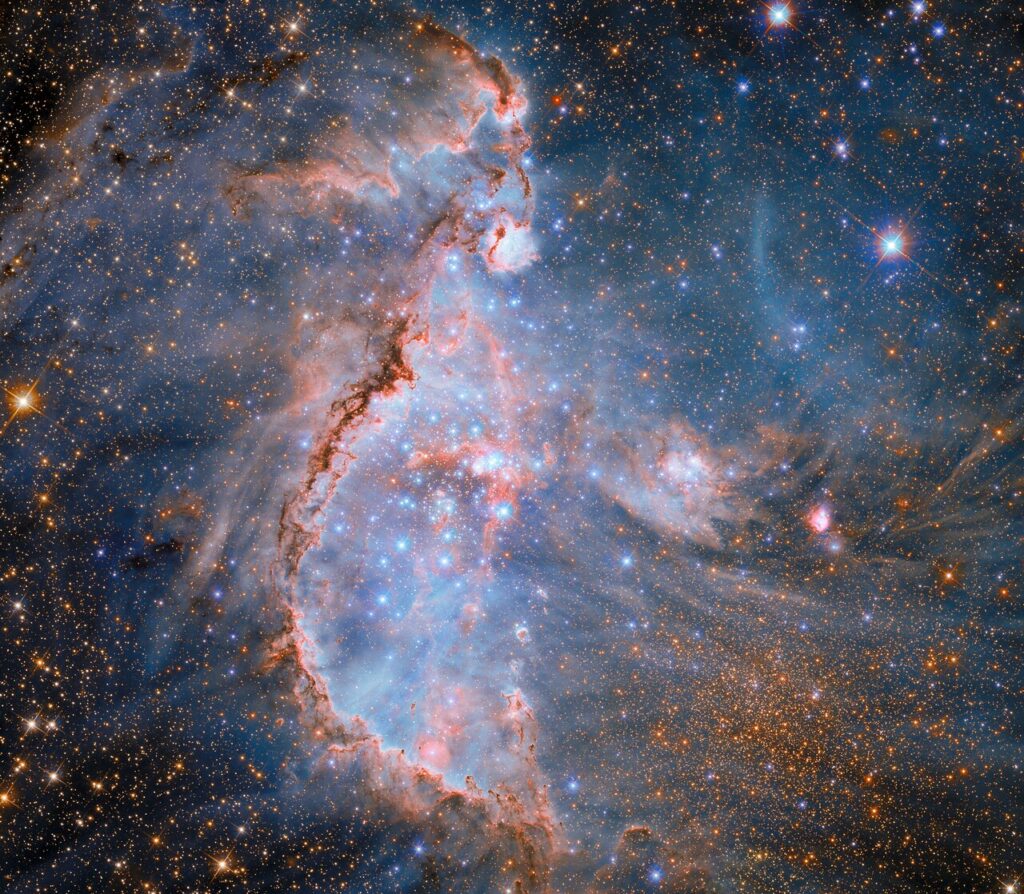
Introduction
The universe is full of surprises, and among its most breathtaking marvels is NGC 346, a radiant star-forming region in the Small Magellanic Cloud—a satellite galaxy orbiting the Milky Way.
This celestial nursery is not only visually stunning but also scientifically significant. It offers astronomers a rare glimpse into how stars formed under early-universe conditions.
What is NGC 346?
NGC 346 lies about 210,000 light-years away in the constellation Tucana. It spans around 200 light-years and contains over 2,500 young stars, many of which are massive and emit intense ultraviolet radiation.
These young stars illuminate and sculpt the surrounding clouds of gas and dust, creating a dramatic and dynamic cosmic landscape.
What makes NGC 346 so unique?
What sets NGC 346 apart is its location in the Small Magellanic Cloud, a galaxy with low metallicity.
This makes it a valuable target for scientists trying to understand how stars formed billions of years ago, under conditions similar to those just after the Big Bang.
The role of Hubble and JWST
Thanks to the powerful eyes of the Hubble Space Telescope and the James Webb Space Telescope (JWST), astronomers can now observe regions in unprecedented detail.
These instruments capture different wavelengths of light, allowing scientists to see deep into dust clouds and analyze the birth and evolution of stars over time.
What can we learn from NGC 346?
By studying, astronomers gain insights into:
- Star formation under primitive cosmic conditions
- Galaxy evolution in chemically simple environments
- The lifecycle of stars from birth to early development
conclution
NGC 346 is more than just a beautiful star cluster—it’s a cosmic time capsule. Through its study, we explore not just a distant part of the sky, but also the early history of the universe itself. It’s a reminder of how far we’ve come in our understanding of the cosmos, and how much more there still is to discover.

Some really great information, Glad I discovered this. “The minute one utters a certainty, the opposite comes to mind.” by May Sarton.
I have not checked in here for a while as I thought it was getting boring, but the last several posts are good quality so I guess I’ll add you back to my daily bloglist. You deserve it my friend 🙂
I thankful to you, that you add my blog to your daily bloglist.
You actually make it seem so easy along with your presentation but I find this matter to be really one thing which I feel I might never understand. It seems too complex and very huge for me. I’m looking forward on your subsequent publish, I?¦ll try to get the hold of it!
It’s really a nice and helpful piece of information. I am glad that you shared this useful information with us. Please keep us informed like this. Thank you for sharing.
thanks man.
I am really loving the theme/design of your web site. Do you ever run into any browser compatibility problems? A handful of my blog visitors have complained about my site not operating correctly in Explorer but looks great in Opera. Do you have any solutions to help fix this issue?
I don’t have any browser compatibility problem. The problem maybe happen your website ‘theme’ section, look the backend then you may find solution.
I like what you guys are up too. Such smart work and reporting! Carry on the superb works guys I’ve incorporated you guys to my blogroll. I think it will improve the value of my website 🙂
F*ckin’ awesome things here. I’m very glad to see your post. Thanks a lot and i’m looking forward to contact you. Will you please drop me a e-mail?
ihrittickdebnath@gmail.com
Hi there, simply become aware of your weblog via Google, and found that it’s really informative. I am gonna watch out for brussels. I’ll be grateful if you happen to continue this in future. A lot of people shall be benefited out of your writing. Cheers!
Great V I should definitely pronounce, impressed with your site. I had no trouble navigating through all tabs as well as related information ended up being truly easy to do to access. I recently found what I hoped for before you know it in the least. Quite unusual. Is likely to appreciate it for those who add forums or something, website theme . a tones way for your client to communicate. Excellent task..